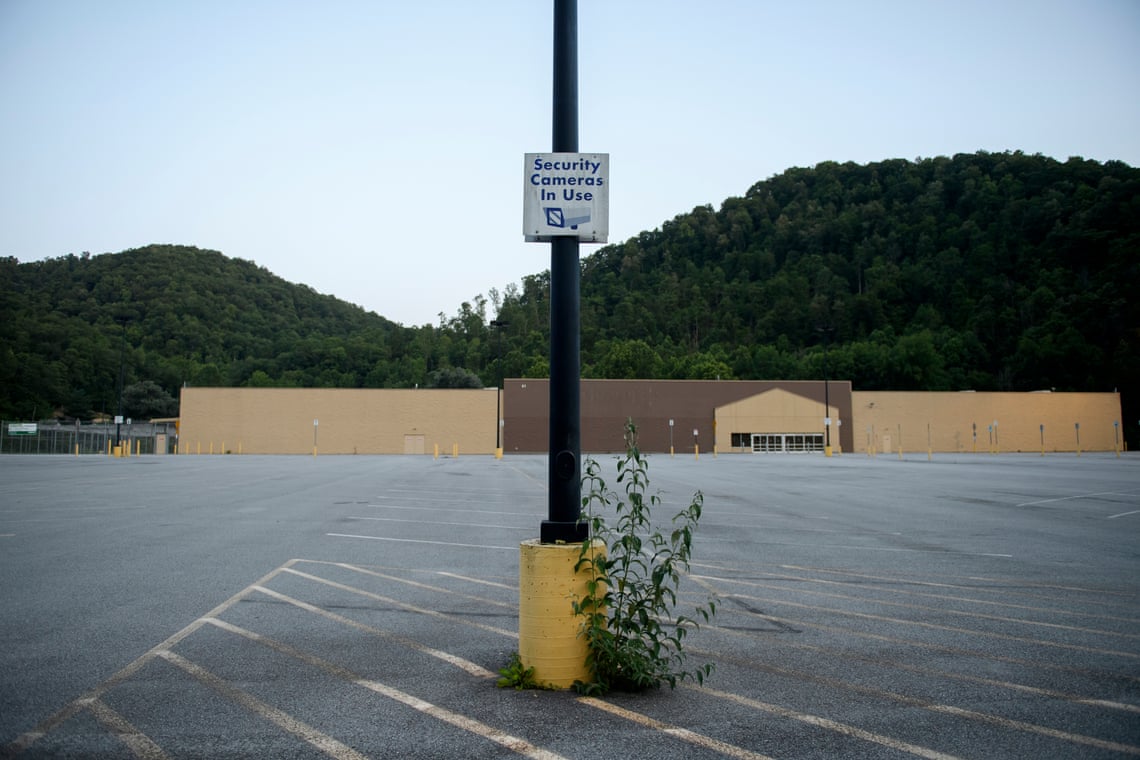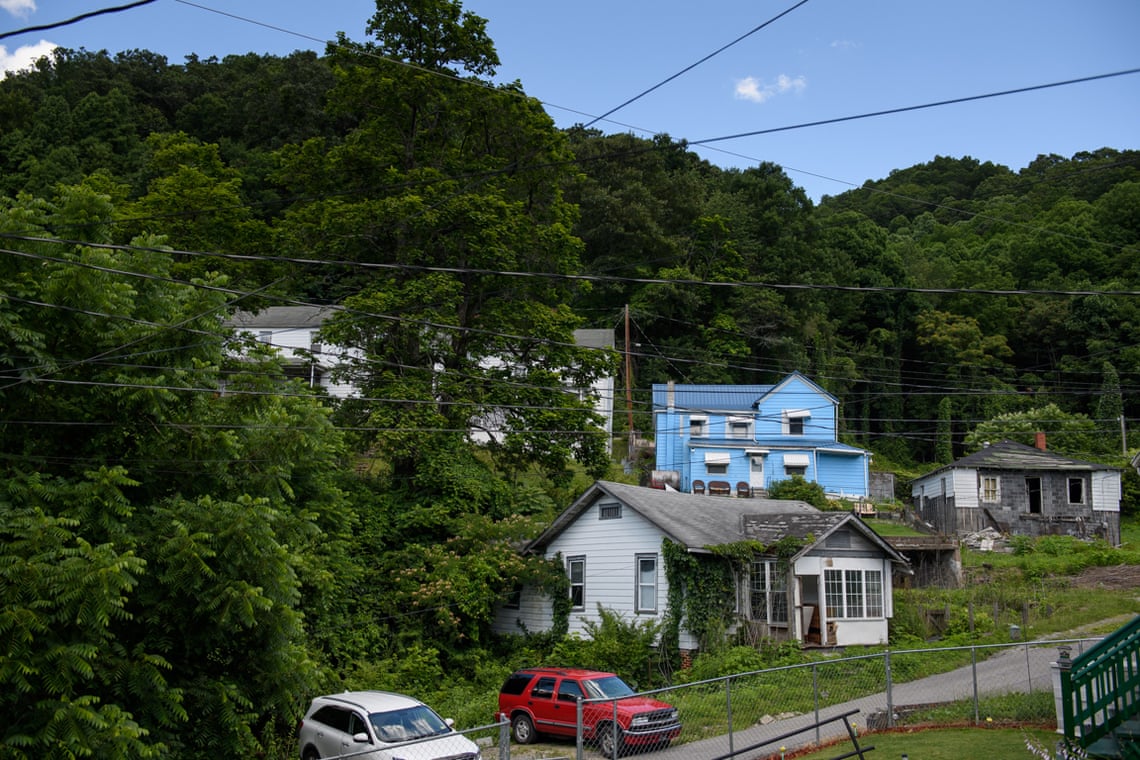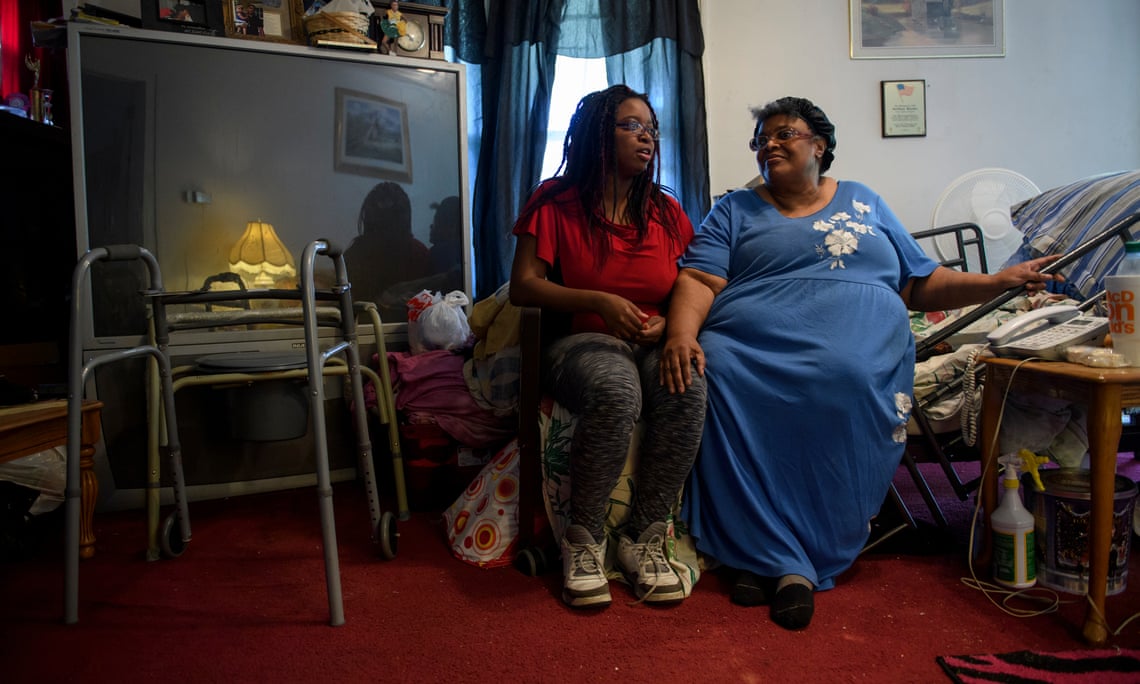What happened when Walmart left
What happened when Walmart left
In West Virginia, the people of McDowell County can’t get jobs, and recently lost their biggest employer – the local Walmart store. They describe the devastating loss of jobs, community and access to fresh food
by Ed Pilkington in McDowell County, West Virginia
Sunday 9 July 2017 12.55 EDT Last modified on Monday 10 July 2017 11.53 EDT
When Walmart left town, it didn’t linger over the goodbyes. It slashed the prices on all its products, stripped the shelves bare, and vanished, leaving behind only the ghostly shadow of its famous brand name and gold star logo on the front wall of a deserted shell.
The departure was so quick that telltale signs remain of the getaway, like smoldering ashes in the fireplaces of an evacuated town. Notices still taped to the glass entranceway record with tombstone-like precision the exact moment that the supercenter was shuttered: “Store closed at 7pm, Thursday 28 January 2016.”
Ten years. That’s all the time it took for the store to rise up in a clearing of the lush forest of West Virginia’s coal country and then disappear again, as though it had never been there.
But for the people of McDowell County – proud country folk laboring under the burdens of high unemployment, low income and endemic ill health – even such a fleeting visit to this rural backwater by the world’s largest retailer had a profound impact. Both in the arrival, and in the hasty leaving.
Wanda Church was present for both of these book-ends of the Walmart story – one of a few workers who helped set up the store in October 2005 and then gut it 10 years, three months and two days later. She remembers the feeling of excitement and expectation as they stocked the supercenter for the very first time, turning it in just 20 days from an empty building into a teeming cathedral of retail capitalism.
“It was amazing what we were able to do, stocking the shelves from nothing to full in such a short time,” she said, talking as she waited for her car to be repaired at a gas station over the road from the disused store. As if to underscore her enduring attachment to the corporation, she was wearing one of her old Walmart T-shirts.
She was there at the supercenter, too, on that fateful day last year when she and her fellow Walmart workers walked out of the store for the last time. “We were all crying. It was a sad day for a lot of people. It was a sad day for me – I spent more of those 10 years at Walmart than I did at my own home.”

The now-empty Walmart in McDowell County, West Virginia. Photograph: Jeff Swensen/Getty for The Guardian
Much has been written about what happens when the corporate giant opens up in an area, with numerous studies recording how it sucks the energy out of a locality, overpowering the competition through sheer scale and forcing the closure of mom-and-pop stores for up to 20 miles around. A more pressing, and much less-well-understood, question is what are the consequences when Walmart screeches into reverse: when it ups and quits, leaving behind a trail of lost jobs and broken promises.
The subject is gathering increasing urgency as the megacorporation rethinks its business strategy. Rural areas like McDowell County, where Walmart focused its expansion plans in the 1990s, are experiencing accelerating depopulation that is putting a strain on the firm’s boundless ambitions.
Hit hard by the longterm decline in coal mining that is the mainstay of the area, McDowell County has seen a devastating and sustained erosion of its people, from almost 100,000 in 1950 when coal was king, to about 18,000 today. That depleted population is today scattered widely across small towns and in mountain hollows (pronounced “hollers”), accentuating the sense of sparseness and emptiness.
The Walmart supercenter is located about five miles from the county seat, Welch, which still boasts imposing brick buildings as a memory of better times. But the glow of coal’s legacy has cooled, as the boarding up of many of the town’s shops and restaurants attests.
When you combine the county’s economic malaise with Walmart’s increasingly ferocious battle against Amazon for dominance over online retailing, you can see why outsized physical presences could seem surplus to requirements. “There has been a wave of closings across the US, most acutely in small towns and rural communities that have had heavy population loss,” said Michael Hicks, an economics professor at Ball State University who is an authority on Walmart’s local impact.
On 15 January 2016, those winds of change swept across the country with a fury. Walmart announced that it was closing 269 stores worldwide, 154 of them in the US. Of those, 14 were supercenters, the gargantuan “big boxes” that have become the familiar face of the company since the first opened in Missouri in 1988.
One of those supercenters was in McDowell County.

McDowell County, where life expectancy for males is 64 years old. Photograph: Jeff Swensen
“It was a big thing for people round here when Walmart pulled out. People didn’t know what to do. Young people started leaving because there’s nothing for them here. It’s like we’re existing, but not existing.”
The words are spoken by Henrietta Banks, 60, who lives just up the hill from the mothballed supercenter. We’re sitting in her front room where she spends much of her time in a hospital bed that has been set up for her as she is treated for congenital heart disease.
She remembers the excitement when the supercenter opened. “People welcomed it with open arms, we needed the jobs,” she said.
But in the end the expectation that Walmart would usher in a new, better era for McDowell County proved illusory. Her late husband Arthur, a former sharpshooter in the US Army who died in 2010, worked as a greeter at Walmart for a few years. He took the job largely in the hope of securing healthcare insurance for Henrietta, but he was told that coverage wasn’t part of the package, and the couple had to make do with Medicaid.
Their daughter Nicole, 25, is sitting beside her mother holding her hand. She works as a corrections officer in a nearby prison, but her dream is to become a therapist.
Given her mother’s health issues, Nicole Banks tries to compensate for Walmart’s departure by seeking out fresh fruit and vegetables in the surrounding area. But it’s not easy. The nearest replacement store, Goodsons, is too expensive, she says, and other Walmarts are an hour’s drive away along Appalachian roads that are as tightly coiled as the copperhead snakes that live in the local forest.
Already, she spends half her $1,200 post-tax monthly salary on car insurance and repayments, and gas for the long drive for groceries eats into the little that is left. So she and her mom grab food where they can, opting for less pricey meals of hamburgers or spaghetti rather than fresh salad that takes another big chunk out of her income.

Henrietta Banks (right) and her daughter Nicole discuss the fallout of the closure of the Walmart in McDowell County. Photograph: Jeff Swensen/Getty for The Guardian
It’s not great for her mother’s health, but then Nicole thinks that’s typical for McDowell County people since Walmart left town. She has noticed that processed foods seem popular again; there are long lines again at the local McDonald’s.
“There’s a lot of people getting sick since the store closed because they’re not getting the right diet. It’s sad to me, but bad food is cheap.”
Nicole Banks is the first person in her family to go to college. With a degree in sociology, how would she sum up the impact of Walmart leaving?
She pauses to think for a while, and when she replies, she does so with unexpected vehemence. “It’s ridiculous,” she says. “People round here can’t get healthcare, they can’t get jobs and now the good food has gone. We are not getting our basic needs met. People are dying young.”
Banks is not exaggerating. Of the 3,142 counties in the US, McDowell County comes in at No 3,142 in terms of life expectancy. For men, that’s 64 years, a statistic that, as Bernie Sanders likes to point out, is the same for men in Namibia.
Clearly, such endemic health problems cannot be laid exclusively at the door of Walmart. But for Sabrina Shrader, a community organizer who was born and bred in the area, it provides the context for understanding the effect of the corporation’s decision, and that of its controlling family, to pack its bags and quit.
“The Walton family are billionaires,” she said (also no exaggeration – their collective worth is put at about $150bn). “They developed a system that just made us worse off, and then they took even that away from us.”
What happened when Walmart left
In West Virginia, the people of McDowell County can’t get jobs, and recently lost their biggest employer – the local Walmart store. They describe the devastating loss of jobs, community and access to fresh food
by Ed Pilkington in McDowell County, West Virginia
Sunday 9 July 2017 12.55 EDT Last modified on Monday 10 July 2017 11.53 EDT
When Walmart left town, it didn’t linger over the goodbyes. It slashed the prices on all its products, stripped the shelves bare, and vanished, leaving behind only the ghostly shadow of its famous brand name and gold star logo on the front wall of a deserted shell.
The departure was so quick that telltale signs remain of the getaway, like smoldering ashes in the fireplaces of an evacuated town. Notices still taped to the glass entranceway record with tombstone-like precision the exact moment that the supercenter was shuttered: “Store closed at 7pm, Thursday 28 January 2016.”
Ten years. That’s all the time it took for the store to rise up in a clearing of the lush forest of West Virginia’s coal country and then disappear again, as though it had never been there.
But for the people of McDowell County – proud country folk laboring under the burdens of high unemployment, low income and endemic ill health – even such a fleeting visit to this rural backwater by the world’s largest retailer had a profound impact. Both in the arrival, and in the hasty leaving.
Wanda Church was present for both of these book-ends of the Walmart story – one of a few workers who helped set up the store in October 2005 and then gut it 10 years, three months and two days later. She remembers the feeling of excitement and expectation as they stocked the supercenter for the very first time, turning it in just 20 days from an empty building into a teeming cathedral of retail capitalism.
“It was amazing what we were able to do, stocking the shelves from nothing to full in such a short time,” she said, talking as she waited for her car to be repaired at a gas station over the road from the disused store. As if to underscore her enduring attachment to the corporation, she was wearing one of her old Walmart T-shirts.
She was there at the supercenter, too, on that fateful day last year when she and her fellow Walmart workers walked out of the store for the last time. “We were all crying. It was a sad day for a lot of people. It was a sad day for me – I spent more of those 10 years at Walmart than I did at my own home.”

The now-empty Walmart in McDowell County, West Virginia. Photograph: Jeff Swensen/Getty for The Guardian
Much has been written about what happens when the corporate giant opens up in an area, with numerous studies recording how it sucks the energy out of a locality, overpowering the competition through sheer scale and forcing the closure of mom-and-pop stores for up to 20 miles around. A more pressing, and much less-well-understood, question is what are the consequences when Walmart screeches into reverse: when it ups and quits, leaving behind a trail of lost jobs and broken promises.
The subject is gathering increasing urgency as the megacorporation rethinks its business strategy. Rural areas like McDowell County, where Walmart focused its expansion plans in the 1990s, are experiencing accelerating depopulation that is putting a strain on the firm’s boundless ambitions.
Hit hard by the longterm decline in coal mining that is the mainstay of the area, McDowell County has seen a devastating and sustained erosion of its people, from almost 100,000 in 1950 when coal was king, to about 18,000 today. That depleted population is today scattered widely across small towns and in mountain hollows (pronounced “hollers”), accentuating the sense of sparseness and emptiness.
The Walmart supercenter is located about five miles from the county seat, Welch, which still boasts imposing brick buildings as a memory of better times. But the glow of coal’s legacy has cooled, as the boarding up of many of the town’s shops and restaurants attests.
When you combine the county’s economic malaise with Walmart’s increasingly ferocious battle against Amazon for dominance over online retailing, you can see why outsized physical presences could seem surplus to requirements. “There has been a wave of closings across the US, most acutely in small towns and rural communities that have had heavy population loss,” said Michael Hicks, an economics professor at Ball State University who is an authority on Walmart’s local impact.
On 15 January 2016, those winds of change swept across the country with a fury. Walmart announced that it was closing 269 stores worldwide, 154 of them in the US. Of those, 14 were supercenters, the gargantuan “big boxes” that have become the familiar face of the company since the first opened in Missouri in 1988.
One of those supercenters was in McDowell County.

McDowell County, where life expectancy for males is 64 years old. Photograph: Jeff Swensen
“It was a big thing for people round here when Walmart pulled out. People didn’t know what to do. Young people started leaving because there’s nothing for them here. It’s like we’re existing, but not existing.”
The words are spoken by Henrietta Banks, 60, who lives just up the hill from the mothballed supercenter. We’re sitting in her front room where she spends much of her time in a hospital bed that has been set up for her as she is treated for congenital heart disease.
She remembers the excitement when the supercenter opened. “People welcomed it with open arms, we needed the jobs,” she said.
But in the end the expectation that Walmart would usher in a new, better era for McDowell County proved illusory. Her late husband Arthur, a former sharpshooter in the US Army who died in 2010, worked as a greeter at Walmart for a few years. He took the job largely in the hope of securing healthcare insurance for Henrietta, but he was told that coverage wasn’t part of the package, and the couple had to make do with Medicaid.
Their daughter Nicole, 25, is sitting beside her mother holding her hand. She works as a corrections officer in a nearby prison, but her dream is to become a therapist.
Given her mother’s health issues, Nicole Banks tries to compensate for Walmart’s departure by seeking out fresh fruit and vegetables in the surrounding area. But it’s not easy. The nearest replacement store, Goodsons, is too expensive, she says, and other Walmarts are an hour’s drive away along Appalachian roads that are as tightly coiled as the copperhead snakes that live in the local forest.
Already, she spends half her $1,200 post-tax monthly salary on car insurance and repayments, and gas for the long drive for groceries eats into the little that is left. So she and her mom grab food where they can, opting for less pricey meals of hamburgers or spaghetti rather than fresh salad that takes another big chunk out of her income.

Henrietta Banks (right) and her daughter Nicole discuss the fallout of the closure of the Walmart in McDowell County. Photograph: Jeff Swensen/Getty for The Guardian
It’s not great for her mother’s health, but then Nicole thinks that’s typical for McDowell County people since Walmart left town. She has noticed that processed foods seem popular again; there are long lines again at the local McDonald’s.
“There’s a lot of people getting sick since the store closed because they’re not getting the right diet. It’s sad to me, but bad food is cheap.”
Nicole Banks is the first person in her family to go to college. With a degree in sociology, how would she sum up the impact of Walmart leaving?
She pauses to think for a while, and when she replies, she does so with unexpected vehemence. “It’s ridiculous,” she says. “People round here can’t get healthcare, they can’t get jobs and now the good food has gone. We are not getting our basic needs met. People are dying young.”
Banks is not exaggerating. Of the 3,142 counties in the US, McDowell County comes in at No 3,142 in terms of life expectancy. For men, that’s 64 years, a statistic that, as Bernie Sanders likes to point out, is the same for men in Namibia.
Clearly, such endemic health problems cannot be laid exclusively at the door of Walmart. But for Sabrina Shrader, a community organizer who was born and bred in the area, it provides the context for understanding the effect of the corporation’s decision, and that of its controlling family, to pack its bags and quit.
“The Walton family are billionaires,” she said (also no exaggeration – their collective worth is put at about $150bn). “They developed a system that just made us worse off, and then they took even that away from us.”




